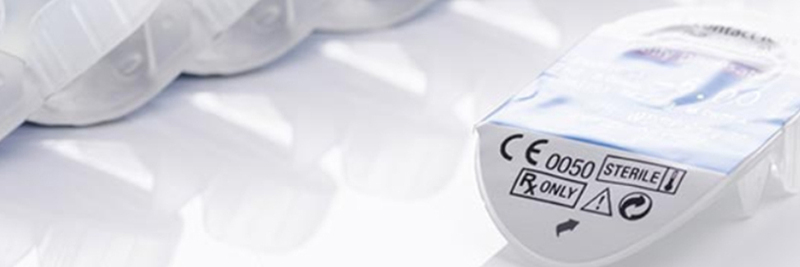
What are silicone hydrogel contact lenses?
Silicone hydrogel contact lenses are a type of soft contact lens, preferred by many over hydrogel lenses or hard contact lenses, due to their increased oxygen permeability.
What is silicone hydrogel made from?
Silicone hydrogels are made from different materials, depending on the manufacturer and lens type. However, all use a combination of hydrophilic gel (or short: hydrogel), which is a water-loving chain of molecules, alongside a silicone polymer with high oxygen permeability.
Types of silicone hydrogel lenses
Silicone hydrogel lenses are available in three different modalities:
Daily
Daily silicone hydrogel contacts are designed for one day of wear, being disposed before you go to sleep. They are ideal for occasional contact lens wearers, don’t require cleaning and are a convenient option.
Weekly
Weekly silicone hydrogels can be worn for up to two weeks, when they are removed, cleaned and stored properly overnight. These are a great choice for those who wear contact lenses regularly and want the same freshness and comfort of daily lenses.
Monthly
Monthly silicone hydrogel lenses can be worn for up to 30 days before they need to be replaced with a new pair. Much like weekly lenses, they need to be removed and cleaned at the end of every day, before being stored overnight. They are a cost-effective option for everyone who wears their lenses most days.

Benefits of silicone hydrogel
The most notable benefit of silicone hydrogels is their improved oxygen permeability, which is superior to that of regular hydrogel contacts. In turn, the lenses are considered as more comfortable and healthier option by some.
Oxygen permeability
Compared to regular hydrogel lenses, the oxygen permeability of silicone hydrogels is significantly higher. This prevents hypoxia from developing, a state of the eye when not enough oxygen reaches it. Hypoxia can increase the risks of eye infections.
Increased comfort
Silicone hydrogels have a lower water content than hydrogels, which reduces the risk of lenses dehydrating during the day. Additionally, because of the increased oxygen permeability, and because silicone hydrogel lenses are designed with a higher resistance to protein deposits, most people find them more comfortable.
They tend to cause less redness, irritation or discomfort, especially over longer wear times.
Disadvantages of silicone hydrogel
Not everyone prefers silicone hydrogel over hydrogel lenses. Though some find that silicone hydrogel lenses may attract more lipid deposits, most struggle with the slightly rigid material or find them too expensive.
Rigidness
Due to the added silicone, these contact lenses hold their shape and are sturdier than hydrogels. While some prefer this for an easier insertion and removal process, others can feel them more compared to hydrogel lenses during initial wear.
Newer generations of silicone hydrogels have addressed this issue and try to make the lenses more flexible.
Costs
Silicone hydrogel contact lenses are considered a higher quality product and therefore come with a higher price than hydrogel contact lenses. Those who find more long-term benefits when wearing hydrogels may not want to pay the higher price.

Silicone hydrogel and allergies
If you suffer from seasonal allergies, such as pollen, or are affected by year-round irritants, like dust or pet hair, contact lens wearers may feel more irritated while affected by their allergies.
The irritants can stick to the surface of the lens and increase the symptoms of itchy and red eyes.
Dust and seasonal allergies
Whether you wear hydrogels or silicone hydrogels, if you are allergic to particles like pollen or dust, it may be recommended to switch to daily contact lenses, as even the most thorough cleaning of reusable lenses can’t guarantee that all the irritants are removed from the lenses at the end of the day.
Your eyes will require oxygen to recover from allergies and the best solution is to pause contact lens wear until your eyes have recovered.
Allergic responses to silicone hydrogel contact lenses
Although some people may experience itchy, sore and watery eyes while wearing their silicone hydrogel lenses, there is no evidence that confirms silicone hydrogels as the cause for an allergic reaction.
However, your eyes shouldn’t feel any discomfort while wearing lenses, so it is advised to discuss a different lens type with your optometrist.
Are silicone hydrogel lenses better?
Everyone has unique eyes and different requirements that need to be considered in their choice for contact lenses. While silicone hydrogel is a newer material and is of great quality to satisfy many contact lens wearers, not everyone prefers them to hydrogel lenses.
Hydrogel contact lenses
Hydrogel contact lenses are thin and flexible, with a higher water content compared to silicone hydrogel lenses. While the water content is a great benefit to keep the eyes feeling comfortable, the water can evaporate during longer periods of wear, which may result in end of day discomfort.
Always discuss your options with your optometrists during a contact lens fitting appointment, to find out whether hydrogel or silicone hydrogel contact lenses are better suited for your eyes.